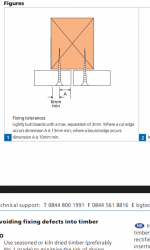If fixing tolerances for joining plasterboards are 6mm plus minimum 13mm for cut edges or minimum 10mm for bound edges on timber, then what are the fixing tolerances when fixing onto metal frames?
Considering most metal c stud profiles provide only 32-34mm, and there could be a maximum separation gap of 3mm between plasterboards...
Considering most metal c stud profiles provide only 32-34mm, and there could be a maximum separation gap of 3mm between plasterboards...




